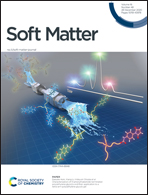Conductive hydrogel composites with autonomous self-healing properties†
Abstract
Conventional conductive hydrogels usually lack self-healing properties, but might be favorable for smart electronic applications. Therefore, we present the fabrication of conductive self-healing hydrogels that merge the merits of electrical conductivity and self-healing properties. The conductive self-healing hydrogel composite was prepared by using single-walled carbon nanotubes (SWCNTs), poly(vinyl alcohol) (PVA), and a poly(N,N-dimethyl acrylamide) copolymer derivative modified with pyrene and borate functional moieties. While the tethered pyrene groups of the copolymer facilitated an even dispersion of the conductive components, i.e., SWCNTs, in aqueous solution via π–π stacking, the hydrogel system was formed via covalent dynamic cross-linking through tetrahedral borate ion interaction with the –OH group of PVA. The hydrogel composites exhibited bulk conductivity (1.27 S m−1 with 8 mg mL−1 SWCNTs) with a fast and autonomous self-healing ability that restored 95% of the original conductivity within 10 s under ambient conditions. Accordingly, due to their outstanding properties, we postulate that these composites may have potential in biomedical applications, such as tissue engineering, wound healing or electronic skins.



 Please wait while we load your content...
Please wait while we load your content...